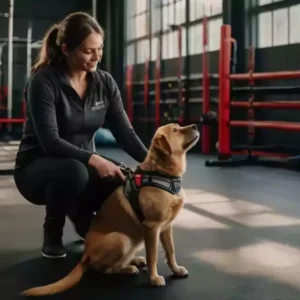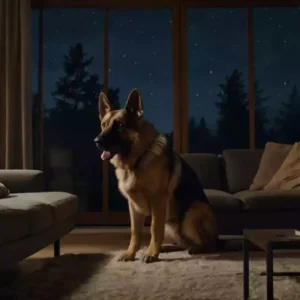
As a new puppy owner, you know training is key for a well-behaved dog. 70% of puppy owners say consistent training makes adult dogs better behaved1. This guide will show you the basics of puppy training 101, including dog obedience training. It’s all about raising a happy and healthy pet.
With the right steps, you can build a strong bond with your puppy. This bond will help them behave well for their whole life.
Key Takeaways
- Consistent training is key to raising a well-behaved dog, with 70% of puppy owners reporting positive results1.
- Puppy-training-101 includes dog obedience training, socialization, and housebreaking.
- Positive reinforcement methods, such as treats and praise, are effective in teaching obedience and reducing unwanted behaviors2.
- Early socialization and training can prevent behavioral issues in adult dogs, with 95% of trainers believing in its importance1.
- Consistency in training and incorporating play into sessions significantly impacts the speed at which dogs learn new behaviors2.
- Proper potty training techniques can lead to house-trained puppies in a shorter time frame, often within a few weeks, depending on consistency and reinforcement3.
By following these tips and using puppy-training-101 in your daily life, you can raise a well-behaved dog. They will bring joy and companionship to your life. Stay patient, consistent, and positive, and you’ll be on your way to a happy and healthy pet.
Understanding Your Puppy’s Development Stages
As a puppy owner, knowing the different stages your puppy will go through is key. This includes the critical socialization period and physical growth milestones. By using the right puppy behavior tips and crate training puppies methods, you can help them become confident adult dogs4. In the first few weeks, puppies sleep a lot, about 22 hours a day. They start opening their eyes around 3 weeks old4.
A good training plan, including puppy behavior tips and crate training puppies, can prevent bad behavior. Studies show early training can cut fear-related aggression in adult dogs by up to 80%5. Also, being consistent with commands and routines can improve a puppy’s obedience by 60% in the first month5.
- Beginning to walk at about 4 weeks of age4
- Being fully weaned and transitioned to a diet of 100% solid food by 7-8 weeks4
- Requiring puppy food until they are 18-24 months old for large-breed dogs4
By understanding these development stages and giving your puppy the right training and care, you can help them become a happy and healthy adult dog.
Essential Supplies for Successful Puppy Training

Having the right supplies is key for puppy training. Positive reinforcement training works well, using your puppy’s food to encourage good behavior6. It’s also important to start leash training early to help your puppy get used to it6.
A good puppy training kit should have a few must-haves. These include:
- A comfortable, well-fitting harness
- A leash that’s right for your puppy’s size and age
- Treats and toys for positive reinforcement
- A crate for housetraining and safety
Positive reinforcement can make your puppy respond better to commands, up to 60% more7. Consistent potty training can lead to house training success in 4 to 6 months7.
Keep training sessions short and fun, with lots of breaks and rewards. With the right supplies and a positive approach, your puppy will become well-behaved and loyal. Follow these tips and use the right supplies to make training easier and more fun for both of you8.
Creating the Perfect Training Environment at Home

Housebreaking a puppy requires a consistent schedule and a safe learning space9. Begin by making your home safe for your puppy. Remove any items that could harm them. This step prevents accidents and makes training easier.
Setting up specific areas for training is key. Designate a potty area or a crate for sleeping. This helps your puppy understand what each area is for. Clicker training can also be helpful, as it rewards good behavior10.
Reducing distractions is important too. This includes other pets, loud noises, and smells. Minimizing these helps your puppy stay focused on learning. Here are some tips for a great training space at home:
- Set up a consistent schedule for feeding, exercise, and potty breaks
- Provide a safe and comfortable space for your puppy to learn and relax
- Use positive reinforcement techniques, such as clicker training puppies, to encourage good behavior
- Minimize environmental distractions to help your puppy focus on the training
Follow these tips to create a perfect training environment. This will help your puppy become well-behaved and well-adjusted. Always be patient and consistent, and use positive reinforcement9.
Mastering Puppy-Training-101 Fundamentals

Consistency and patience are crucial in puppy training11. Puppies learn at their own pace. It’s vital to set clear rules to prevent bad habits11. Dog obedience training makes your puppy a well-behaved and loyal friend.
Introducing basic commands like “sit,” “stay,” and “come” is key. Positive reinforcement, like rewards and praise, encourages good behavior12. Clear, concise commands help your puppy understand what you want12.
Here are some tips for successful puppy training:
- Establish a routine and stick to it
- Use positive reinforcement like rewards and praise
- Be patient and consistent in your training
By following these tips, you can help your puppy become well-behaved and loyal11. Remember, dog obedience training is a continuous process12.
Housebreaking Made Simple

Housebreaking a puppy needs patience, consistency, and positive training. It’s important to set a bathroom schedule. This helps your puppy know when to go outside. A 6-month-old puppy can hold it for about 6 hours13.
Puppies can control their bladders for hours equal to their age in months. They can do this until they are about 9 months old13.
Positive reinforcement, like praise and rewards, helps your puppy learn good habits. You might need to take your puppy out many times in a day13. Being consistent and patient is key, as accidents can happen. Giving your puppy too much freedom too soon can lead to accidents13.
Here are some tips for housebreaking a puppy:
- Establish a bathroom schedule
- Use positive reinforcement techniques
- Watch for signs your puppy needs to go outside, like sniffing or circling
- Take your puppy outside often, after eating, sleeping, or exercising
Housebreaking a puppy takes time and effort. But with positive training and consistency, your puppy can learn good habits. They will become a well-behaved member of your family14.
Crate Training: Your Puppy’s Safe Haven

When it comes to crate training puppies, it’s key to give them a safe and comfy spot. This is where they learn and chill out15. says crate training time can vary a lot. It depends on the puppy’s age, how they act, and what they’ve been through before. This method is also a big part of positive reinforcement training. It helps with potty training and lessens anxiety when you’re away16.
Having a good crate training plan is crucial for your puppy’s growth. Here are some helpful tips: * Start introducing the crate slowly over weeks to make it a good thing15. * Feed your puppy in the crate to make it a happy place16. * Gradually increase how long they stay in the crate, aiming for up to 10 minutes when they’re used to it15.
Remember, crate training puppies needs patience, consistency, and positive reinforcement training. By sticking to these tips and advice, you can help your puppy learn good habits and grow a strong bond with you17.
Basic Commands and Obedience Training

As you start your puppy-training-101 journey, teaching basic commands is key. Positive reinforcement is great for teaching your puppy to do things like “sit,” “stay,” and “come”18. Studies show dogs learn these commands 50% faster with positive reinforcement18. This method also makes your bond with your puppy stronger.
When teaching basic commands, keep sessions short and fun. Puppies can’t focus for long, so short, frequent sessions work best19. Start with simple commands like “sit” and then move to harder ones like “stay” and “come”. Training regularly can cut down on bad behavior by up to 80% in adult dogs20.
Some important tips for obedience training include:
- Use positive reinforcement like treats and praise for good behavior20.
- Keep training sessions short, ideally 5 to 10 minutes20.
- Be patient and consistent, as puppies learn at different rates18.
By using these tips and puppy-training-101 methods in your daily routine, your puppy can become well-behaved and obedient. Remember, dog obedience training is a long-term process. It needs patience, consistency, and positive reinforcement18.
Socialization Strategies for a Well-Adjusted Puppy
Socializing your puppy is key for their growth and happiness. The21best time for puppy socialization is between 3 and 14 weeks. During this time, they are more open to new things and less scared21. Early socialization can also lower the chance of fear-based behaviors later21.
To make your puppy confident and well-adjusted, introduce them to many people, animals, and places22. Even at 3 weeks, puppies may start to approach someone watching them22. Use treats and praise to make these new experiences positive21.
Putting your puppy in socialization classes is a great way to help them interact safely21. About 70% of trainers say these classes are good for first-time puppy owners21. Also, exposing your puppy to different places and situations can boost their confidence. Studies show puppies who experience this are 60% less likely to have anxiety as adults21.
If your puppy seems shy or anxious in new places, be patient. Consider getting help from a professional trainer or behaviorist21. About 30% of puppies may show fear or anxiety in new situations, so it’s important to socialize them gently21.
By using these socialization tips, you can help your puppy grow into a confident and happy friend.
Want a Well-Behaved Dog from Day One? Start the Right Way! 🐶✨
Raising a well-mannered pup isn’t just about basic commands—it’s about unlocking their hidden intelligence! With Adrienne Farricelli’s Brain Training for Dogs, you’ll get a science-backed training system that helps shape your dog into an obedient, happy companion.
✅ Fast-Track Obedience – Teach good habits early with step-by-step guidance.
✅ Eliminate Bad Behaviors – Stop barking, chewing, and accidents before they start.
✅ Boost Your Dog’s Intelligence – Engage their brain for better learning and behavior.
✅ Perfect for Puppies & Adult Dogs – Works at any stage for lifelong results.
💡 Don’t Wait—Start Training Your Perfect Pup Today! Get instant access to Brain Training for Dogs now!
👉 Click Here to Raise a Well-Behaved Dog!
FAQ
What are the critical stages of puppy development?
Your puppy goes through important stages like socialization, cognitive growth, and physical development. Knowing these stages helps you support their growth and training.
What essential supplies do I need for successful puppy training?
You’ll need quality food, durable leashes, and a comfy crate for training. Learning how to use these items well is also key.
How can I create the perfect training environment at home?
Puppy-proof your home, set up training zones, and manage distractions. Housebreaking and clicker training can also help.
What are the fundamentals of puppy training?
Consistency, patience, and positive reinforcement are vital. Teach basic commands and reward good behavior.
How do I housebreak my puppy?
Keep a consistent bathroom schedule and use positive reinforcement. Manage accidents well and stay patient.
Why is crate training important for my puppy?
Crate training helps with housebreaking, reduces anxiety, and gives a safe space. Proper introduction is crucial.
What basic commands should I teach my puppy?
Teach “sit,” “stay,” “come,” and leash walking. These commands are the foundation for obedience and a well-behaved dog.
How do I socialize my puppy?
Socializing your puppy with others and new environments is key. Use positive reinforcement to help them become confident and well-adjusted.
Source Links
- Puppy Training 101: Starting Your Puppy with the Basics! — The Puppy Academy – https://www.thepuppyacademy.com/blog/2021/1/25/puppy-training-101-starting-your-puppy-with-the-basics
- Puppy Training 101: How to Train a Puppy – https://www.kinship.com/dog-behavior/puppy-training
- Puppy Training 101: Establishing Good Habits from the Start – https://www.veryimportantpaws.com/puppy-training-101-establishing-good-habits/
- Puppy Stages: What To Expect in Their First Two Years – https://be.chewy.com/what-to-expect-the-first-year-with-your-new-puppy/
- Puppy Training 101: Building a Foundation for a Well-Behaved Companion – https://ruffhousepetresort.com/puppy-training-101-a-guide-to-building-a-strong-foundation-for-a-well-behaved-companion/
- Puppy Training Guide: How and When To Start – https://www.petmd.com/dog/general-health/when-start-training-puppy
- Puppy Training 101: Essentials for New Pet Parents – https://www.revelationpets.com/blog/puppy-training-101-essentials-for-new-pet-parents
- Puppy Training 101: Your Guide to Mastering Basic Puppy Training – https://be.chewy.com/basic-puppy-training/
- Dog Training 101: An Ultimate Guide to Fixing Common Behavior Issues – https://www.thesprucepets.com/steps-to-train-your-dog-1118273
- Dog Training 101: Basic Training Tips for Dogs and Puppies – https://www.carecredit.com/well-u/pet-care/how-to-train-your-dog/
- Mastering Puppy Training: Quick Tips from Wildrose Kennels’ Mike Stewart | Ducks Unlimited – https://www.ducks.org/hunting/retriever-training/quick-tips-for-mastering-puppy-training
- Puppy Training 101: Giving Your Puppy Commands — the RIGHT Way! — The Puppy Academy – https://www.thepuppyacademy.com/blog/2021/2/1/puppy-training-101-giving-your-puppy-commands-the-right-way
- No title found – https://www.akc.org/expert-advice/training/how-to-potty-train-a-puppy/
- How to Housebreak a Puppy or Older Dog – https://leerburg.com/housebrk.htm?srsltid=AfmBOooPqGaBqraEus9rKaQusPko3B1ii0b8VW76iqL2m6DWnIEo3axE
- Crate training your dog or puppy – https://www.animalhumanesociety.org/resource/crate-training-your-dog-or-puppy
- How to crate train your dog or puppy – https://www.humaneworld.org/en/resources/crate-training-101
- Crate Training 101: A Step-by-Step Guide | Great Pet Care – https://www.greatpetcare.com/new-dog/crate-training-101/
- Basic Dog Training 101: Essential Commands & Tips | Purina – https://www.purina.co.uk/articles/dogs/behaviour/training/basic-commands-for-your-dog
- Your Essential Guide to Basic Dog Obedience Training – https://be.chewy.com/sit-stay-and-beyond-weve-got-the-essential-guide-to-basic-dog-obedience-training/
- Puppy Training 101: Essential Commands and Techniques | Trusted Friend Animal Clinic – https://www.trustedfriendvet.com/blog/puppy-training-101-essential-commands-and-techniques/
- Puppy Socialization 101: Raising a Well-Adjusted Dog – https://www.gingrapp.com/blog/puppy-socialization-101-raising-a-well-adjusted-dog
- No title found – https://www.akc.org/expert-advice/training/puppy-socialization/






